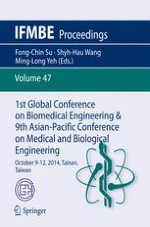2015 | Buch
1st Global Conference on Biomedical Engineering & 9th Asian-Pacific Conference on Medical and Biological Engineering
October 9-12, 2014, Tainan, Taiwan
herausgegeben von: Fong-Chin Su, Shyh-Hau Wang, Ming-Long Yeh
Verlag: Springer International Publishing
Buchreihe : IFMBE Proceedings
